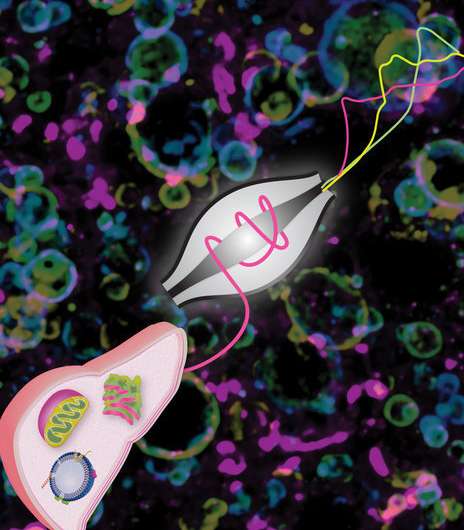Fatty liver changes the distribution and activity of proteins

Chronic excessive caloric intake leads to the deposition of fat droplets in the liver. This condition, known as fatty liver, can cause permanent damage to the organ. Researchers at the Max Planck Institute of Biochemistry in Martinsried have now investigated the effects of this fat overflow on liver proteins. They showed that fatty liver is associated with changes in the location and activity of numerous cellular proteins. The study shows the effect of lipid deposition on fundamental cellular processes in the liver.
The high-calorie and high-fat diet now common in many parts of the world, including Europe and North America, can lead to a wide range of health problems. This diet frequently results in obesity, which places a heavy strain on the cardiovascular system, but it can also damage the liver. It is estimated that around 30 percent of the population is affected by fatty liver, an initially reversible accumulation of fat droplets in liver cells. In the long run, these deposits can lead to inflammation and irreversible liver damage. The effects of fat droplets on the biology of liver cells has now been investigated in detail by researchers in Matthias Mann's Proteomics and Signal Transduction Department at the MPIB in Martinsried. For the study, the researchers collaborated with the research group headed by Ralf Jungmann at the MPIB and with scientists from the Helmholtz Center München and Harvard University, USA.
Disorder in protein distribution
The liver is one of the most versatile organs in the human body. In addition to detoxifying the blood, it plays a key role in the metabolism of sugars, proteins and fats. These nutritional components can be temporarily stored in liver cells. Liver cells, like most cells of highly developed organisms, contain various functionally and structurally distinct areas known as organelles. The researchers used state-of-the-art mass spectrometry methods to determine the entire set of proteins, known as the proteome, of cell organelles. Mass spectrometry is a type of molecular scale used to identify proteins.
The researchers studied the protein composition of organelles in liver samples taken from mice that were given a normal or a high-calorie diet. As in humans, increased caloric intake leads to fatty degeneration of the liver in mice. "We found that as a result of fatty liver 20 percent of the proteins occurred in different organelles than in healthy organs. The fat droplets in the cells bind hundreds of different proteins on their surface. These are drawn away from other processes and organelles," explains Natalie Krahmer, postdoc at the Max Planck Institute of Biochemistry and lead author of the study. "The resulting disorder shows that it is not only important whether and in what amount proteins are present in cells, but also where they are." The researchers also found proteins attached to the fat droplets whose functions are still completely unknown.
Trigger for a vicious circle
Particularly, changes in location affected proteins of the Golgi apparatus. The Golgi apparatus is an organelle that is responsible for the formation of transport vesicles in the cell. "We observed a vicious circle: the large number of fat droplets alters the structure of the Golgi apparatus and reduces its activity in liver cells. And because the Golgi apparatus is required for fat release from the cells, which counteracts the fatty degeneration of cells, the process accelerates. Restoring the structure of the Golgi apparatus could therefore be a therapeutic goal to slow the progression of fatty liver," Krahmer says.
The researchers also investigated the occurrence of molecular protein switches, a phenomenon known as phosphorylation, with the help of the EasyPhos method developed at the Max Planck Institute of Biochemistry. Phosphorylation can alter the activity of proteins. Many of the proteins whose location was shifted in fatty liver also showed changes in their phosphorylation patterns. "However, we were not able to conclude from the findings whether this is the consequence or cause of the altered protein distribution," Krahmer explains.
Max Planck Director Matthias Mann summarizes the current research findings: "At the moment, there are no treatment options for fatty liver other than a change in diet. However, until now the cellular effects of such changes were largely unknown. We hope that our research will identify therapeutic targets for slowing the progression of fatty degeneration of the liver." In any case, he says, the observed effects on the Golgi apparatus, the still unknown proteins involved in fatty deposits and the altered phosphorylation patterns open up many avenues for future research.
More information: Natalie Krahmer et al. Organellar Proteomics and Phospho-Proteomics Reveal Subcellular Reorganization in Diet-Induced Hepatic Steatosis, Developmental Cell (2018). DOI: 10.1016/j.devcel.2018.09.017



















